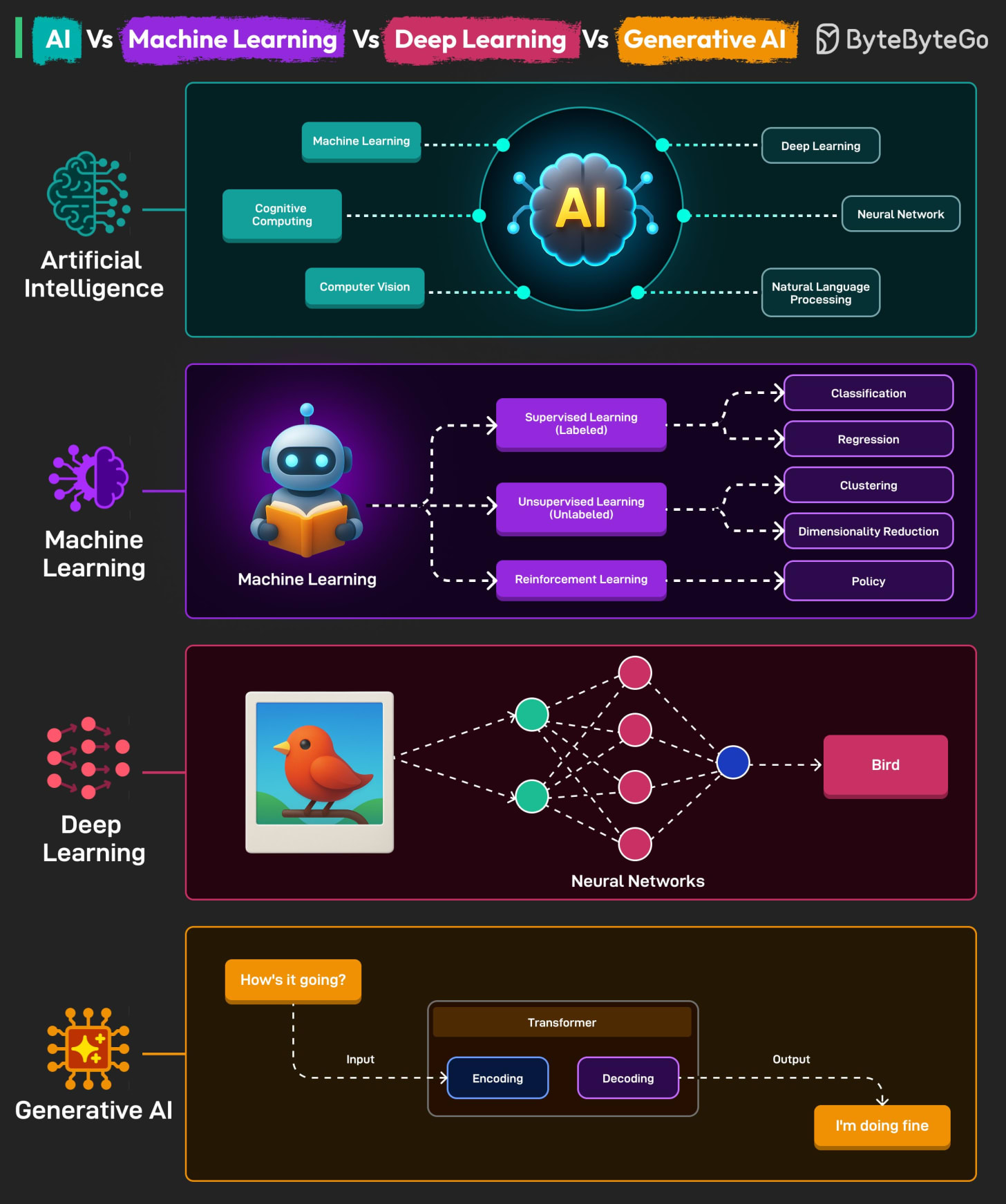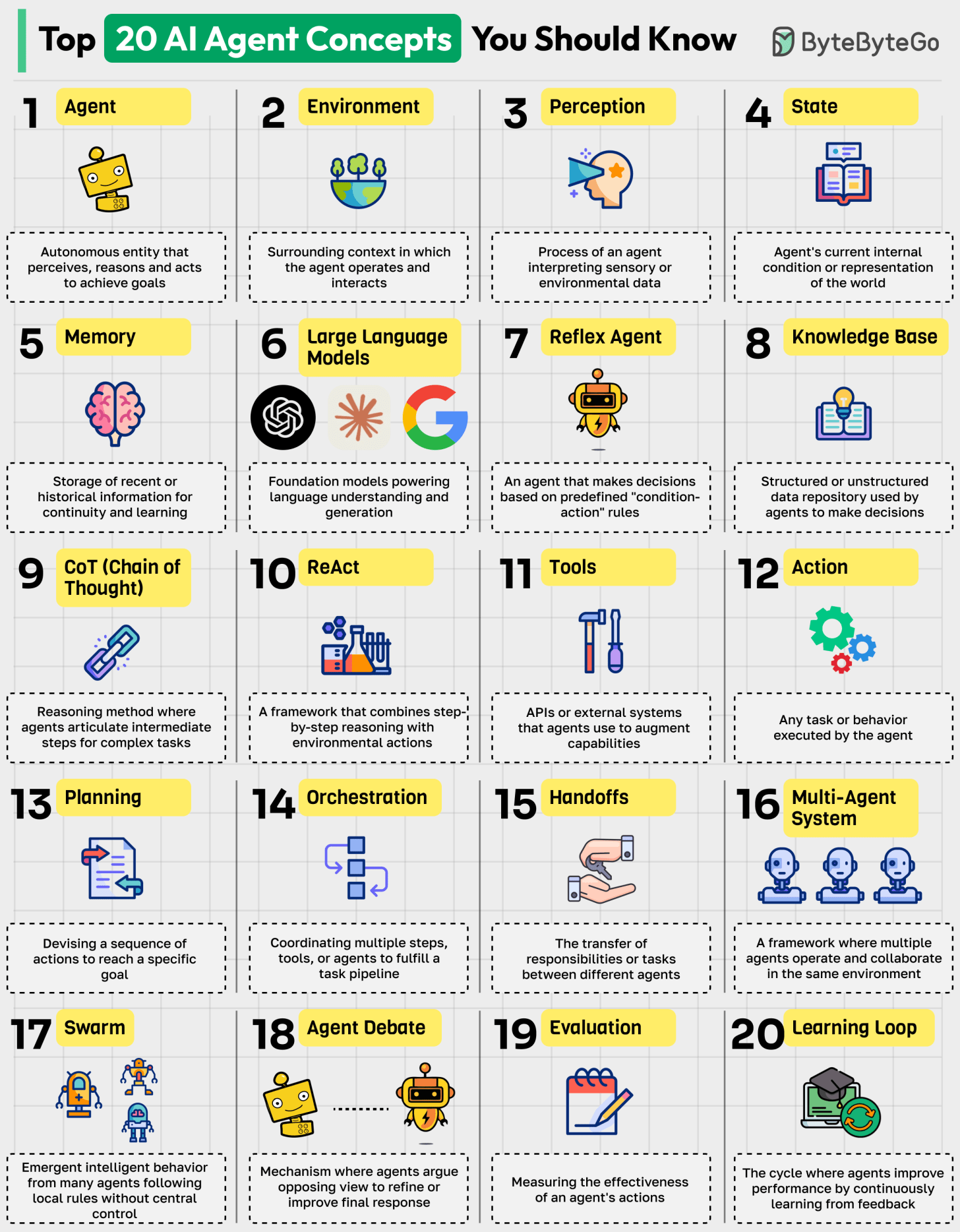✂️ Cut your QA cycles down to minutes with QA Wolf (Sponsored)
If slow QA processes bottleneck you or your software engineering team and you’re releasing slower because of it — you need to check out QA Wolf.
QA Wolf’s AI-native service supports web and mobile apps, delivering 80% automated test coverage in weeks and helping teams ship 5x faster by reducing QA cycles to minutes.
QA Wolf takes testing off your plate. They can get you:
Unlimited parallel test runs for mobile and web apps
24-hour maintenance and on-demand test creation
Human-verified bug reports sent directly to your team
Zero flakes guarantee
The benefit? No more manual E2E testing. No more slow QA cycles. No more bugs reaching production.
With QA Wolf, Drata’s team of 80+ engineers achieved 4x more test cases and 86% faster QA cycles.
This week’s system design refresher:
AI Vs Machine Learning Vs Deep Learning Vs Generative AI
How SQL Query Executes In A Database?
Top 20 AI Agent Concepts You Should Know
How RabbitMQ Works
Hiring Now
SPONSOR US
AI Vs Machine Learning Vs Deep Learning Vs Generative AI
Artificial Intelligence (AI)
It is the overarching field focused on creating machines or systems that can perform tasks typically requiring human intelligence, such as reasoning, learning, problem-solving, and language understanding. AI consists of various subfields, including ML, NLP, Robotics, and Computer Vision
Machine Learning (ML)
It is a subset of AI that focuses on developing algorithms that enable computers to learn from and make decisions based on data.
Instead of being explicitly programmed for every task, ML systems improve their performance as they are exposed to more data. Common applications include spam detection, recommendation systems, and predictive analytics.
Deep Learning
It is a specialized subset of ML that utilizes artificial neural networks with multiple layers to model complex patterns in data.
Neural networks are computational models inspired by the human brain’s network of neurons. Deep neural networks can automatically discover representations needed for future detection. Use cases include image and speech recognition, NLP, and autonomous vehicles.
Generative AI
It refers to AI systems capable of generating new content, such as text, images, music, or code, that resembles the data they were trained on. They rely on the Transformer Architecture.
Notable generative AI models include GPT for text generation and DALL-E for image creation.
Over to you: What else will you add to understand these concepts better?
Level Up Your API Stack with Postman (Sponsored)
Your API workflow is changing whether you like it or not. Postman just dropped features built by devs like you to help you stay ahead of the game.
Postman’s POST/CON 25 product reveals include real-time production visibility with Insights, tighter spec workflows with Spec Hub + GitHub Sync, and AI-assisted debugging that actually works.
Think native integrations that plug directly into your stack—VS Code, GitHub, Slack—plus workflow orchestration without infrastructure headaches.
Get the full technical breakdown and see what your API development could look like.
How SQL Query Executes In A Database?
STEP 1
The query string first reaches the Transport Subsystem of the database. This subsystem manages the connection with the client. Also, it performs authentication and authorization checks, and if everything looks fine, it lets the query go to the next step.
STEP 2
The query now reaches the Query Processor subsystem, which has two parts: Query Parser and Query Optimizer.
The Query Parser breaks down the query into sub-parts (such as SELECT, FROM, WHERE). It checks for any syntax errors and creates a parse tree.
Then, the Query Optimizer goes through the parse tree, checks for semantic errors (for example, if the “users” table exists or not), and finds out the most efficient way to execute the query.
The output of this step is the execution plan.
STEP 3
The execution plan goes to the Execution Engine. This plan is made up of all the steps needed to execute the query.
The Execution Engine takes this plan and coordinates the execution of each step by calling the Storage Engine. It also collects the results from each step and returns a combined or unified response to the upper layer.
STEP 4
The Execution Engine sends low-level read and write requests to the Storage Engine based on the execution plan.
This is handled by the various components of the Storage Engine, such as the transaction manager (for transaction management), lock manager (acquires necessary locks), buffer manager (checks if data pages are in memory), and recovery manager (for rollback or recovery).
Over to you: What else will you add to understand the execution of an SQL Query?
Top 20 AI Agent Concepts You Should Know
Agent: An autonomous entity that perceives, reasons, and acts in an environment to achieve goals.
Environment: The surrounding context or sandbox in which the agent operates and interacts.
Perception: The process of interpreting sensory or environmental data to build situational awareness.
State: The agent’s current internal condition or representation of the world.
Memory: Storage of recent or historical information for continuity and learning.
Large Language Models: Foundation models powering language understanding and generation.
Reflex Agent: A simple type of agent that makes decisions based on predefined “condition-action” rules.
Knowledge Base: Structured or unstructured data repository used by agents to inform decisions.
CoT (Chain of Thought): A reasoning method where agents articulate intermediate steps for complex tasks.
ReACT: A framework that combines step-by-step reasoning with direct environmental actions.
Tools: APIs or external systems that agents use to augment their capabilities.
Action: Any task or behavior executed by the agent as a result of its reasoning.
Planning: Devising a sequence of actions to reach a specific goal.
Orchestration: Coordinating multiple steps, tools, or agents to fulfill a task pipeline.
Handoffs: The transfer of responsibilities or tasks between different agents.
Multi-Agent System: A framework where multiple agents operate and collaborate in the same environment.
Swarm: Emergent intelligent behavior from many agents following local rules without central control.
Agent Debate: A mechanism where agents argue opposing views to refine or improve outcomes.
Evaluation: Measuring the effectiveness or success of an agent’s actions and outcomes.
Learning Loop: The cycle where agents improve performance by continuously learning from feedback or outcomes.
Over to you: Which other AI agent concept will you add to the list?
How RabbitMQ Works?
RabbitMQ is a message broker that enables applications to communicate by sending and receiving messages through queues. It helps decouple services, improve scalability, and handle asynchronous processing efficiently.
Here’s how it works:
A producer (usually an application or service) sends messages to the RabbitMQ broker, which manages message routing and delivery.
Within the broker, messages are sent to an exchange, which determines how they should be routed based on the type of exchange: Direct, Topic, or Fanout.
Bindings connect exchanges to queues using a binding key, which defines the rules for routing messages (for example, exact match or pattern-based)
Direct exchanges route messages to queues that match the routing key exactly, as shown with Queue 1.
Topic exchanges use patterns to route messages to matching queues.
Fanout exchanges broadcast messages to all bound queues, regardless of routing keys.
Finally, messages are pulled from the queues by a consumer, which processes them and can pass the results to other systems.
Over to you: What else will you add to the RabbitMQ process flow?
Hiring Now
We collaborate with Jobright.ai (an AI job search copilot trusted by 500K+ tech professionals) to curate this job list.
This Week’s High-Impact Roles at Fast-Growing AI Startups
Senior / Staff Software Engineer, Data Platform at Waabi (California, USA)
Yearly: 155000 - 240000
Waabi is an artificial intelligence company that develops autonomous driving technology for the transportation sector.
Senior Full Stack Engineer at Proton.ai (US)
Yearly: 60000 - 90000
Proton.ai is an AI-powered sales platform for distributors to gain millions of revenue and reclaim market share.
Software Engineer - Frontend UI at Luma AI (Palo Alto, CA)
Yearly: 220K - 280K
Luma AI is a generative AI startup that enables users to transform text descriptions into corresponding 3D models.
High Salary SWE Roles this week
Principal Engine Engineer, Avatar Systems at Roblox (San Mateo, CA)
Yearly: 289460 - 338270
Director of Engineering - AWS Applied AI Solutions at Amazon Web Services (Seattle, WA)
Yearly: 264100 - 350000
Manager, Software Engineering - Interactive Foundations at Figma (New York, NY)
Yearly: 250000 - 350000
Today’s latest ML positions
Applied Machine Learning Engineer - Causal Inference Recommendation at DoorDash (Sunnyvale, CA)
Yearly: 137100 - 201600
Lead Machine Learning Engineer at Adobe (New York, NY)
Yearly: 162000 - 301200
Lead Machine Learning Engineer at ESPN (New York, NY)
Yearly: 175800 - 235700
SPONSOR US
Get your product in front of more than 1,000,000 tech professionals.
Our newsletter puts your products and services directly in front of an audience that matters - hundreds of thousands of engineering leaders and senior engineers - who have influence over significant tech decisions and big purchases.
Space Fills Up Fast - Reserve Today
Ad spots typically sell out about 4 weeks in advance. To ensure your ad reaches this influential audience, reserve your space now by emailing sponsorship@bytebytego.com.







